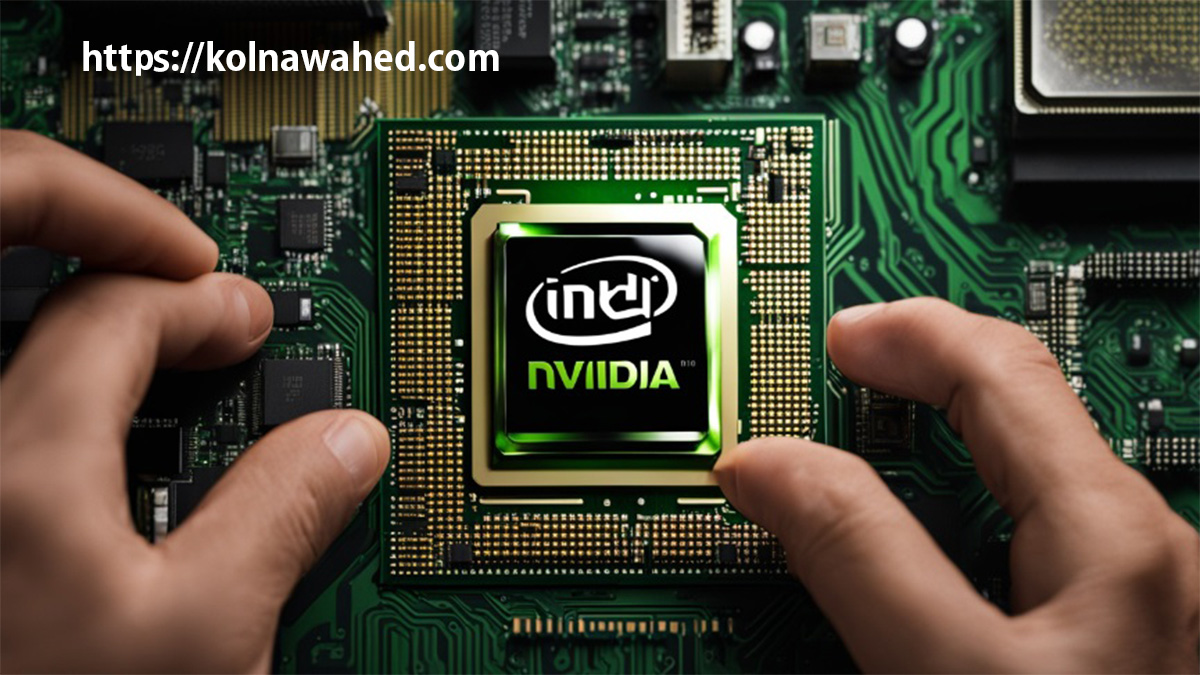Nvidia’s Customers: AI Chip Maker’s Biggest Threat

Nvidia is a leader in AI chip development in the fast-changing semiconductor industry. But its biggest challenge might not be from other companies. Instead, it could come from its own customers, like Google, Amazon, and Microsoft. These tech giants are now seeing Nvidia as a strong competitor, threatening its top spot in the market.
The tech world is going through big changes, making it hard to tell who is a customer and who is a competitor. Nvidia’s AI chips have been key in powering data centers and speeding up AI tasks. Now, these chips are helping its customers make their own solutions. This has sparked a fierce fight for who can design the best chips, especially in the booming cloud computing field.
The battle in cloud computing has made things even more intense. Nvidia’s customers want a bigger piece of the data center and hardware acceleration markets. This puts Nvidia in a tough spot, trying to keep its market share while keeping good relationships with these big companies. The future of AI chips looks set to be complex and ever-changing, with lines between working together and competing getting more mixed up.
Nvidia’s Dominance in AI Chip Market
Nvidia leads the AI chip market, powering data centers and cloud computing. Their chips are key for many AI applications. They are the top choice for leading tech companies around the world.
Powering Data Centers and Cloud Computing
Nvidia’s AI chips are crucial for the data center revolution. They provide efficient computing power for cloud infrastructure. This helps businesses and consumers with fast cloud computing.
Accelerating Artificial Intelligence Applications
Nvidia’s chips are used in many AI applications, not just data centers. They support machine learning, natural language processing, computer vision, and autonomous systems. This makes Nvidia a leader in AI technology.
Nvidia’s chips are chosen for their great performance, energy efficiency, and versatility. This has made Nvidia a key player in AI technology. They help drive progress in data centers, cloud computing, and AI applications.
“Nvidia’s AI chips are at the heart of the data center revolution, enabling efficient and scalable computing power for the ever-growing demands of cloud infrastructure.”
The Rise of Customer Rivalry
Nvidia leads the AI chip market, but its success has brought an unexpected challenge. Tech giants like Amazon, Google, and Microsoft now see Nvidia as a threat. They use Nvidia’s AI chips in their data centers and cloud computing. But they want to make their own AI chips to lessen their reliance on Nvidia.
This has led to a rise in customer rivalry. These tech giants aim to develop their own custom AI chips. They want to beat Nvidia in the semiconductor industry and technology rivals world.
“The more successful Nvidia becomes, the more some of its largest customers view the company as a potential threat to their own ambitions.”
They want more control over AI workloads. By making their own AI chips, they can match their hardware to their needs. This could make them better than Nvidia’s chips and give them an edge.
- Amazon has developed its own Graviton processors for its cloud computing services, challenging Nvidia’s dominance in the data center market.
- Google has created its Tensor Processing Unit (TPU) chips to accelerate its machine learning and AI applications.
- Microsoft is collaborating with chipmakers like Graphcore to develop custom AI accelerators for its Azure cloud platform.
The semiconductor industry is changing fast. The rise of customer rivalry is a big challenge for Nvidia. The company must stay ahead in the AI chip market. It also needs to meet the growing needs and goals of its rivals.
Nvidia’s biggest customers are also the AI chip maker’s biggest threat
The tech giants that once bought a lot from Nvidia are now its main rivals. Companies like Google, Amazon, and Microsoft see the value in making their own AI chips. They’re putting a lot of money into making their own chips to lessen their need for Nvidia’s.
Tech Giants: From Customers to Competitors
These big companies know that having control over the hardware for AI and cloud services is key. By making their own AI chips, they can make things work better, use less power, and save money. This move from nvidia’s biggest customers to customer to competitor has made waves in the industry. Nvidia now faces the tough task of competing with its tech giants.
“The tech giants have recognized that their future success in AI and cloud computing is closely tied to their ability to control the underlying hardware.”
As tech giants pour billions into their chip design, Nvidia’s lead in the AI chip market is facing its biggest challenge. The fight for chip design leadership is just starting. It will decide the future of the tech giants and Nvidia’s place in the industry.
The Battle for Chip Design Supremacy
The tech world is in the middle of a thrilling fight for chip design supremacy. Nvidia leads the AI chip market, but its customers want to make their own customized AI chips. They aim to get ahead in the game.
These special chips fit certain tasks perfectly. They let big tech companies like Google, Amazon, and Microsoft optimize performance. With their big resources and know-how, they’re making chips that meet their exact needs.
Customized AI Chips for Optimal Performance
The push for chip design supremacy is all about getting better performance and efficiency. Custom AI chips let companies tweak hardware and software. This means better optimal performance for certain tasks.
- Optimized for specific workloads and use cases
- Improved energy efficiency and reduced power consumption
- Enhanced computational capabilities tailored to AI and machine learning tasks
As big tech keeps investing in customized AI chip projects, the chip industry is changing. Nvidia is facing stiff competition from its own customers.
“The battle for chip design supremacy is not just about raw performance, but also about the ability to tailor hardware to specific needs and applications.”
Semiconductor Industry’s Shifting Dynamics
The semiconductor industry is changing fast. The way Nvidia and its customers work together is getting more complex. Tech giants are now trying to make their own chips, which challenges Nvidia’s top spot in the market.
As the semiconductor industry changes, customer competition and technology rivals are making waves. Nvidia used to be the top name in AI chips. But now, its customers want to make their own special processors for their needs.
This change is big news for everyone in the industry. Companies are fighting hard to stand out. They’re using their big resources and know-how to make AI chips that work best for their needs.
“The semiconductor industry is at a crossroads, as the traditional boundaries between customers and suppliers are being redrawn. This new era of competition and collaboration will undoubtedly shape the future of the industry.”
The semiconductor industry is facing big challenges. The fight for chip design leadership is getting fierce. The winner will not just get more market share and profits. It will also change the tech world a lot.
The Cloud Computing Arms Race
The cloud computing industry is now a fierce competition. Tech giants are racing to build their cloud infrastructure and offer top-notch computing services. This has sparked a cloud computing arms race. Companies are trying to create the most efficient and powerful hardware acceleration solutions for their data centers and accelerating cloud infrastructure.
Nvidia is a key player in the AI chip market. With a huge demand for powerful AI chips, Nvidia’s customers, including tech giants, are both its allies and rivals.
Accelerating Cloud Infrastructure
Companies are investing a lot in accelerating cloud infrastructure because of the need for faster, more efficient computing power. This has led to a lot of activity. Tech giants are racing to make custom AI chips and hardware acceleration solutions for cloud-based applications and services.
The cloud computing arms race is now a fight for chip design supremacy. Nvidia’s customers want to make their own specialized chips to get ahead. This has challenged Nvidia’s lead in the AI chip market and changed the semiconductor industry.
“The cloud computing arms race has become a battle for chip design supremacy, as Nvidia’s customers seek to gain a competitive edge by developing their own specialized chips.”
Data Centers and Hardware Acceleration
Data centers are now key to innovation and growth in the semiconductor world. Nvidia leads in the data center market with its powerful hardware acceleration solutions. But, this success has made Nvidia a top target for customers wanting to beat the competition with their own chips.
The need for fast computing in data centers has grown fast. This is because of the rise of artificial intelligence, machine learning, and other data-heavy tasks. Nvidia’s GPUs have been key in handling these tasks, offering top performance and efficiency.
But, the industry is changing. Companies like Amazon, Google, and Microsoft are spending big on their own custom chips. These chips are made to fit their data center needs, which could challenge Nvidia’s lead in hardware acceleration.
“The data center has become the new battleground for the semiconductor industry, and Nvidia finds itself at the center of this competition.”
The fight for chip design leadership is getting tougher. For Nvidia, keeping its market share and innovating will be key. The company must adjust its plans to keep up with customer competition and stay important in the fast-changing data center world.
- Nvidia’s success in the data center market makes it a prime target for its customers.
- Customers are now investing in developing their own custom-designed chips to optimize performance for their specific needs.
- The demand for high-performance computing power in data centers is fueling the competition in the semiconductor industry.
Advanced Computing: A Double-Edged Sword
Nvidia’s work in advanced computing has had both good and bad sides. On one side, it has empowered customers to make more powerful computing tools. But, it has also enabled competitors to start their own chip design work.
The fast growth in AI chip tech has helped Nvidia’s customers, like big tech companies and cloud providers. They can now make top-notch apps and services. This has really helped them.
But, these same abilities have let these companies enable competitors. They use their own research and development to make chips just for their needs.
“Nvidia’s innovations have been a double-edged sword, empowering customers while also enabling competitors to emerge as potential rivals.”
This change has made the semiconductor industry more competitive. Now, Nvidia’s big customers are also strong competitors in making chips. The fight for market share and leading in tech has gotten fiercer. Big tech companies are putting a lot into making their own advanced computing solutions.
Handling this double-edged sword will be tough for Nvidia. It needs to keep leading the market and keep innovating in AI chips. The company must balance what its customers need with keeping its competitive edge.
Nvidia’s Strategic Response
Nvidia’s customers have grown into strong competitors. The company has come up with a strategic plan to keep its lead. It aims to protect its market share and keep innovating.
Nvidia is focused on staying on top in the AI chip market. It’s looking into new partnerships and strategies to stay ahead.
Protecting Market Share and Innovation
Nvidia knows how crucial it is to keep its market share. It invests a lot in research and development. This keeps its AI chips leading in performance and efficiency.
Nvidia also works closely with its customers. It offers customized solutions and support to meet their needs.
Moreover, Nvidia is all about protecting innovation in AI chips. It guards its intellectual property with its large patent portfolio. This stops competitors from copying its technology.
Nvidia also teams up with academia and research centers. This helps it stay ahead and spot new trends in artificial intelligence.
“Nvidia is committed to maintaining its position as the leader in AI chip technology. We will continue to innovate, partner, and adapt to ensure that our customers have access to the most advanced and efficient solutions in the market.”
— Jensen Huang, CEO of Nvidia
The Future of AI Chip Competition
The AI chip competition is set to get even more intense. Nvidia is facing stiff competition from its customers-turned-competitors in the semiconductor industry. Tech giants are racing to lead in advanced computing and cloud computing. This will lead to a lot of new innovation and changes in the industry.
Because of customer competition, Nvidia needs to rethink its strategies. Tech giants are now making their own customized AI chips. This move is to improve performance and get ahead in the market.
This change has sparked a data center arms race. Companies are working hard to create the best and most efficient cloud infrastructure. As technology rivals keep pushing the limits of computing, Nvidia must keep innovating to stay ahead.
“The future of the AI chip market will be defined by the ability of companies to stay ahead of the curve, continuously innovate, and adapt to the evolving needs of their customers.”
To stay competitive, Nvidia needs to strengthen its ecosystem partnerships and look into new areas for growth. This could mean moving into new technologies and offering more products. The future of AI chip competition will be crucial, with the winners setting the course for the semiconductor industry for years ahead.
As the AI chip competition gets fiercer, companies must be ready for a fast-changing scene. Customer competition and the drive for technological supremacy will shape the industry’s future.
Partnerships and Ecosystem Strategies
Nvidia is looking into new partnerships and ecosystem strategies as the semiconductor industry changes. These partnerships and collaborations could help Nvidia stay on top and keep pushing innovation despite more competition from its customers.
Creating a strong ecosystem is key in the tough semiconductor industry. Nvidia knows no one can do everything in advanced computing alone. By working with others, it can use their skills and resources to make top solutions.
- Nvidia is teaming up with top tech companies, research places, and startups to grow its reach and use others’ strengths.
- These partnerships cover areas like artificial intelligence, cloud computing, and data center setup. This helps Nvidia stay ahead and meet its customers’ changing needs.
- With a strong ecosystem, Nvidia can draw on more talent, ideas, and resources. This makes it stronger in the market and pushes the semiconductor industry forward.
“Partnerships and ecosystem strategies are key for Nvidia to lead in the fast-changing semiconductor industry. Working with different groups lets the company use its strengths and stay ahead of the competition.”
As the semiconductor industry keeps changing, Nvidia’s focus on partnerships and ecosystem strategies will help it keep its lead. It will also drive the next wave of advanced computing solutions.
Conclusion
Nvidia leads the AI chip market, but its success attracts fierce competition from its customers. These customers now compete with Nvidia in the chip design race. The future of AI chip competition will be shaped by their innovative strategies and rivalries.
The fight for top spot in AI chips shows how fast the semiconductor industry changes. Nvidia must keep up by adapting, innovating, and making strategic partnerships. It needs to stay ahead of its competitors.
This article shows how important it is to be adaptable, innovative, and strategic in AI chip technology. Nvidia’s story warns leaders to watch the industry closely. As the battle for AI chip dominance grows, Nvidia’s influence will keep shaping advanced computing and technology.
FAQ
What are Nvidia’s biggest customers, and how have they become the AI chip maker’s biggest threat?
Nvidia’s top customers like Google, Amazon, and Microsoft are now its main rivals. They rely on Nvidia’s AI chips but see them as a threat. This has sparked a fierce competition as these giants aim to make their own AI chips.
How has Nvidia dominated the AI chip market?
Nvidia leads the AI chip market, powering data centers and cloud computing. Its GPU chips are essential for many tech companies.
What is the battle for chip design supremacy, and how are Nvidia’s customers customizing their own AI chips?
Customers of Nvidia are now making their own AI chips. These chips are made for specific tasks, helping companies improve their performance and stand out in the market.
How has the semiconductor industry’s dynamics shifted as Nvidia’s customers have become competitors?
The semiconductor industry is changing as Nvidia and its customers face off. What was once a simple supplier-customer relationship has turned complex. Tech giants are now challenging Nvidia’s dominance by designing their own chips.
How has the cloud computing arms race impacted the demand for powerful AI chips?
The cloud computing field is a key area of competition for Nvidia and its customers. As companies build their cloud services, the need for strong AI chips grows. This has led to a race for the best hardware solutions.
How have Nvidia’s advancements in AI chip technology both empowered and enabled its customers to become competitors?
Nvidia’s AI chip tech has helped its customers a lot. But it has also let them become rivals by boosting their chip design skills.
What strategic responses has Nvidia adopted to address the threat posed by its customers-turned-competitors?
Nvidia is fighting back against its new competitors. It’s focusing on keeping its market share and innovating in AI chips. The company is also looking for new partnerships to stay ahead.
What is the future of AI chip competition, and how are partnerships and ecosystem strategies shaping the semiconductor industry?
The AI chip market will likely get more competitive as Nvidia faces off against its customers. To stay on top, Nvidia is looking at new partnerships and strategies. These moves could help it keep its edge in a tough market.







